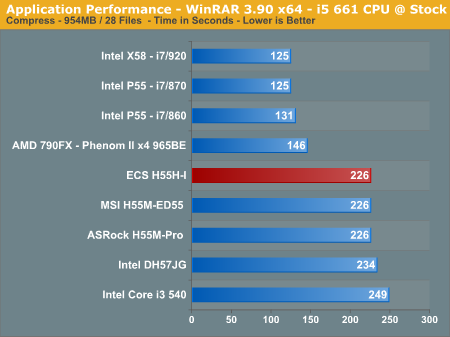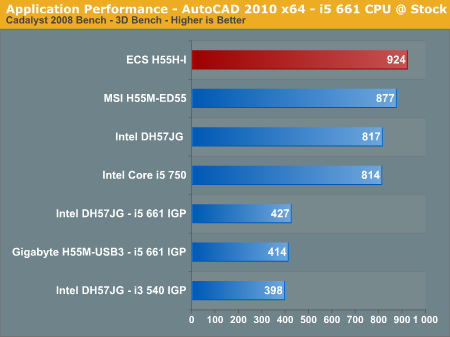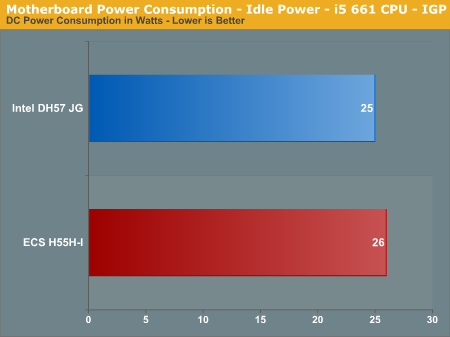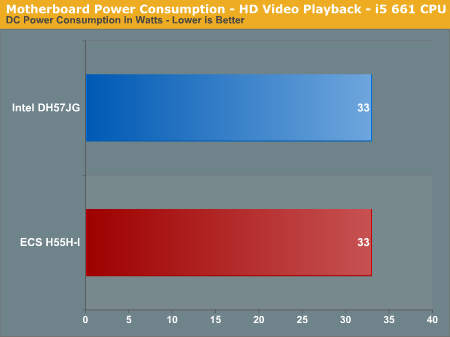ECS H55H-I Review: Mini-ITX at a Sensible Price
by Rajinder Gill on May 6, 2010 6:59 AM EST- Posted in
- Motherboards
Let’s start off with the basic compares:



The H55H-I performs admirably in our benchmark suite, placing mid to top tier in every benchmark we threw at it.
Power Consumption
Our power consumption testing utilizes the same batch of components under similar circumstances in a bid to monitor variances between idle and CPU load conditions. We install the vendor supplied power saving utilities on each board (when available) and enable power saving modes that don't involve any kind of underclocking or CPU core frequency modulation in order to run an apples to apples comparison.
ATX PSU switching losses are absent from our figures because we monitor power consumption directly at the DC rails of the PSU. These figures measure only the CPU, motherboard and memory DC power draw and exclude any other peripherals, such as cooling fans and hard drives etc. AC power consumption at the wall will be anywhere from 15~40% higher than these figures depending upon the efficiency of your power supply.


The DC power consumption figures are almost identical to Intel's DH57JG in every day usage.
Overclocking
The inclusion of over-voltage options for CPU VCore, VTT and VDIMM open the door to a reasonable level of overclocking with Clarkdale processors:

4GHz is attainable on the H55H-I, surpassing the Intel DH57JG.
We added a 0.1V voltage boost to CPU VCore (ignore the 2.20V shown in the CPU-Z screenshot, it's around 1.23V), VTT and VDIMM for the above screenshot and proceeded to pass two hours of Linpack without a glitch. The BIOS does allow you to push higher if you want to, although we think it’s probably safe to stick at a 4GHz limit given the perceived abilities of ECS’ VRM (3 Phase for VCC using 30 amp FETs, giving a theoretical 90 amp maximum under a best case scenario). Bear in mind that if running with the IGP active, you’ll be limited somewhere around 165BCLK anyway, because there is no way to change the IGP clock ratio in BIOS or increase voltage to the graphics core.
For those of you wondering about Lynnfield overclocking, do yourself a favor and don't take any of the four core processors above stock on this board - there's not enough power on tap to sustain the load.










67 Comments
View All Comments
yyrkoon - Thursday, May 6, 2010 - link
Like the subject line says. I have this CRAAAAAZY idea. How about instead of trying to OVERCLOCK the dammed board. How about you try and do something insane such as use the board for it intended purpose, and *maybe* underclock / undervolt the board ?
But Gee, I guess that would make too much sense eh ? Just because you can try and do something. Does not mean that you *should* do it.
Rajinder Gill - Thursday, May 6, 2010 - link
I had flashes of those ideas too. They were swiftly tempered when i found that the BIOS has no undervolt options, a minimum BCLK of 133 and broken control of CPU multiplier ratios.With regards to underclocking and undervolting; power gating on C-States is pretty good, so there's not much if any saving to be had in very light load situations when you've got no effective multiplier control and a minimum BCLK of 133. Best thing you can do with the board in its current state if you want to encourage ultra-low power consumption and low levels of heat is to use Windows power options to set a high load threshold for SpeedStep ramping (low multiplier VID is programmed around 0.85V on the Clarkdale CPUs).
Hope that helps.
Raja
xrror - Tuesday, June 1, 2010 - link
I have this crazy idea too, that this is the first time I've seriously considered an ITX board because ECS was cool enough to allow real overclocking. I also find it pretty great that they do allow you to overspec the power. I wish there was some way to send a "bravery" award to the BIOS engineer(s) who slipped that through.So either heatsink like mad and hope you can stave off burning the power section with your 4.5Ghz i7 - or admit the fact that burning up 2 of these boards is STILL CHEAPER than most other ITX boards that don't even have this much overclocking flex.
Wow, really ECS maybe IS getting back to it's overclocking roots. ECS boards were common overvolt-mod fodder because of this. Which is a good thing - just to clarify that I'm NOT slamming ECS.
Since otherwise it's just time to get a Dell.
cjs150 - Friday, May 7, 2010 - link
At least for me as I am about to build a home server box.Boards like this are perfect. Stick a RAID card in the PCI-Ex16 slot then add 4x2TB HD and works just as I want.
Now all I have to understand is how to set Linux as my primary domain controller for a network of Windows box (window 7, vista and XP pro) and I will be rocking
jillsean - Friday, May 7, 2010 - link
Just a quick one Raja.Would you say this is a better board than the Zotac H55 mini ITX, especially when it comes to overclocking and stability? Also, do you know if you can change the IGP clock ratio on the Zotac H55 board?
Many thanks in advance.
Rajinder Gill - Friday, May 7, 2010 - link
Hi,Assuming ECS don't back-track, the H55H-I is probably a tad better for overclocking Clarkdale processors. Zotac's board is limited to using stock VTT.
If you can look past the overclocking/underclocking stuff, the only reason I can see to buy the Zotac relates to the additional USB ports on the rear I/O panel (10) and the inclusion of WiFi. Otherwise, it's ECS all the way.
Raja
jaydee - Friday, May 7, 2010 - link
What does it take to switch between a graphics card and the IGP? If you have a discrete card in, but want to use the IGP (for power savings), can you reboot and change something easily in the BIOS? With monitors coming with more than one DVI or HDMI input, this would be handy.Or is it the case, that as long as the discrete card is detected, it will always be on, no matter what?
Rajinder Gill - Friday, May 7, 2010 - link
Hi,As soon as you plug a discrete card into the PEG slot, the IGP switches off - and there's now way to activate it again unless you remove the discrete card. BIOS does not offer any option for switch-over unfortunately. I don't have a discrete PCIe soundcard here, but suspect that would have a similar effect on this board too (I should have a soundcard here soon I can test this).
regards
Raja
Rajinder Gill - Friday, May 7, 2010 - link
As soon as you plug a discrete card into the PEG slot, the IGP switches off - and there's *no* way to activate it again unless you remove the discrete card.strikeback03 - Friday, May 7, 2010 - link
Really? That would be a massive mistake if plugging in ANY PCIe device kills the onboard video, a discrete GPU isn't the only thing a user might want in that slot.